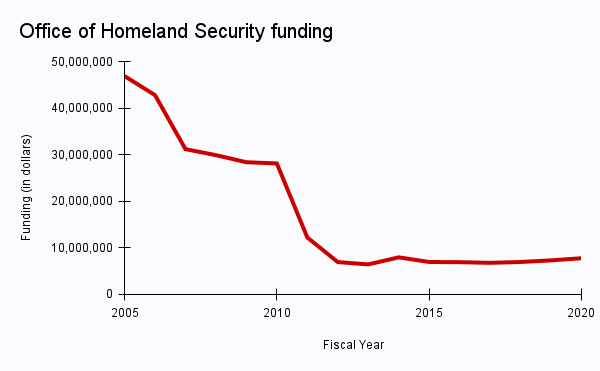Missouri’s Office of Homeland Security suffers $40 million in budget cuts since its post-9/11 height
JEFFERSON CITY, Mo. (KMIZ)
Missouri was the first state to create an Office of Homeland Security following the terrorist attacks on Sept. 11, 2001. Though it continues to protect Missourians in 2021, its budget has dropped from nearly $47 million in 2005 to less than $8 million in FY 2020.

Former Missouri Gov. Bob Holden held office during the attack and subsequently led the charge to ensure a safe and secure Show-Me State.
"I was still at the mansion, waiting to go to the Capitol, which is a block away, and got word that a plane had flown into the towers in New York," Holden said in an interview with ABC 17 News. "Nobody knew whether it was an accident or what was going on. But as the minutes unfolded, became very obvious that it was a planned attack.
"And then there was a second plane that hit the towers in New York. Then I was taken to a secure location for the rest of the morning. Nobody knew what was going on. It was a pretty tense experience, to say the least. The important part, I think, for me, is what we did after."
Just 15 days later, Holden appointed Tim Daniel as his special adviser on Homeland Security, creating the Office of Homeland Security in Missouri. In the role, Daniel headed up efforts to analyze potential exposure spots for threats in the Show-Me State and develop emergency preparedness plans.
"Fortunately, we didn't have any terrorist attack," Holden said. "But we were prepared for it and ready for it, if it happened again, how to respond to it . . . The unfortunate thing is in government, when you don't have a crisis, after time, goes on, people get less concerned, and they don't think well, that that can't happen again. "
Watch an ABC 17 News special interview with Daniel from a year after the attacks in the player below.
In the months following the attack, concrete barriers were erected around the state Capitol and the Truman Building in Jefferson City. Metal detectors were also installed at the Capitol. In the years following the attack, the homeland security office focused on enhancing information-sharing and communications, along with training and emergency preparedness.
In 2005, the office moved to Missouri's Department of Public Safety. Now, Public Safety Director Sandy Karsten serves as homeland security adviser to the Governor.
When New York's police and fire departments responded to the Twin Towers on 9/11, they were unable to communicate with each other due despite being in the same location. In response to the disfunction, the federal government ordered states to create interoperable communications systems by January 2013. The state homeland security office developed the Missouri Interoperability Center and the Missouri Statewide Interoperability Network to ensure that agencies can communicate with each other in emergency situations.
"The communication network became a priority for the state," Karsten said. "For example, that network replaced the highway patrol's communication network that had been around since World War II."
The Office of Homeland Security is a relatively small program within the Department of Public Safety and mainly serves as a coordinator of regional security efforts and a pass-through for federal funding.
There are 10 regional homeland security advisory councils throughout the state. Separated into the Missouri State Highway Patrol troop districts, the councils must have the following roles in their membership:
- Director of Emergency Management
- Chief of Police
- County Sheriff
- Chief of Fire
- County Health
- Homeland Security Response Team (HSRT)
- City or County Public Works
- Mayor or City Administrator
- County Commissioner
- Private Industry/Public Utility
- Emergency Medical Service
- 911
- Volunteer Sector
- Schools
Karsten said the regional councils help ensure locals are prepared for all kinds of disasters, not just terrorist attacks.
"We've built out core capabilities in our areas across the state, whether that's to respond to a flooding event, or whether it's a tornado in Jeff City or Joplin. You see the effects of that training and the equipment come into play during those time periods."
Another example of how the increased information-sharing has been used in the Show-Me State happened in July. Following a deadly shooting in Lake Ozark involving motorcycle clubs, agencies coordinated and exchanged information about the incident.
"When that occurred, there was a lot of information shared throughout the state on what might be happening in the days that followed, or what might occur at the funeral services for the person that was killed," Karsten said. "So a lot of information sharing so that people are prepared for what might come to their community."
